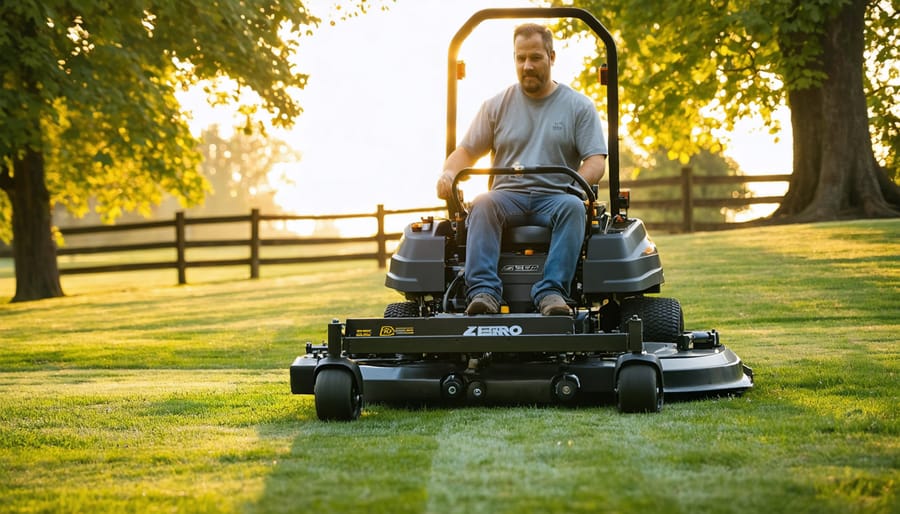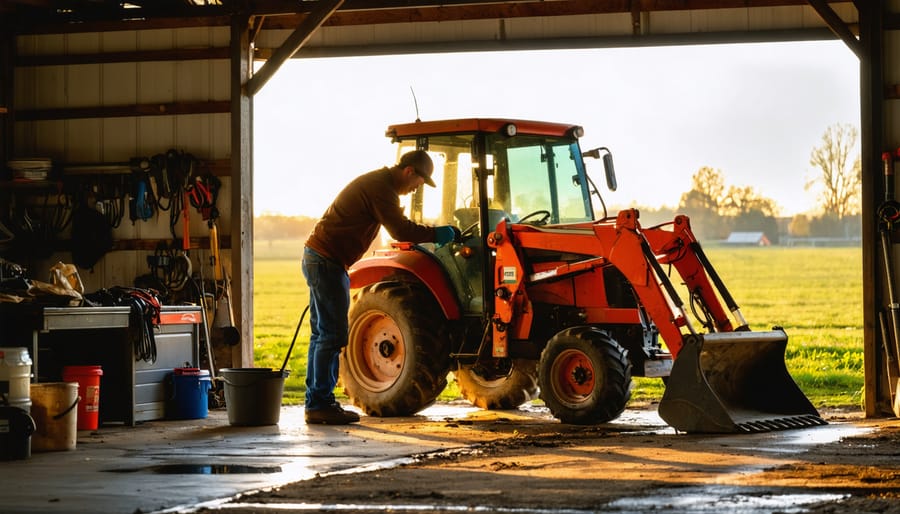Match your mower deck to your acreage and terrain before assuming bigger is better. For properties between 5-10 acres with open, flat terrain, a 60-72 inch deck delivers optimal productivity, cutting your mowing time nearly in half compared to residential models. Beyond 10 acres or for commercial operations, 72-inch models from brands like Scag, Toro, and Hustler become cost-effective investments, though they require 36-inch gate access and skilled operation.
Evaluate your property’s obstacles carefully, since the widest cutting decks sacrifice maneuverability around trees, garden beds, and tight corners. A 72-inch deck might save an hour on open ground but add 30 minutes navigating landscaped areas, making a 60-inch model more practical for properties with extensive ornamental features. These zero-turn mowers excel at straight-line speed but require different operating techniques than smaller residential units.
Consider the environmental impact of your choice, as larger decks typically require more powerful engines consuming additional fuel. However, they reduce total mowing time, potentially offsetting higher fuel consumption per hour with fewer hours spent cutting. The sweet spot for most large property owners sits between 60-66 inches, offering impressive productivity without the transportation challenges, storage requirements, and maneuverability limitations of true commercial-grade 72-inch behemoths.
Calculate your return on investment by comparing the price premium of larger decks against realistic time savings for your specific property layout and maintenance schedule.
What Makes a Zero-Turn Mower ‘Large Cut’?
When you’re shopping for a powerful mowing machine, you’ll often hear the term “large cut” thrown around, but what does it actually mean? In the world of zero-turn mowers, this designation typically refers to cutting decks measuring 60 inches or wider. To put that in perspective, most residential mowers sport decks between 42 and 54 inches, so we’re talking about a significant jump in coverage.
The beauty of these larger decks lies in simple math. A 60-inch deck covers five feet of ground with every pass, while a 72-inch model sweeps an impressive six feet. This translates directly to fewer passes across your property and substantially less time in the seat. For context, upgrading from a 48-inch deck to a 72-inch deck can cut your mowing time nearly in half on open terrain.
Here’s where it gets practical for you: deck size should align with your property’s acreage. Generally speaking, 60-inch decks work beautifully for properties between 3 and 5 acres, while 72-inch monsters shine on spreads of 7 acres or more. Commercial operators managing multiple large properties or sports fields often choose decks extending to 96 inches or beyond.
However, bigger isn’t always better for every situation. These wide decks require more engine power to maintain blade speed, which means higher fuel consumption. They’re also considerably heavier and wider, making them less maneuverable around tight landscaping features or through narrow gates. You’ll want to measure your property’s access points before committing to a particularly large deck.
The sustainability angle matters too. While larger decks consume more fuel per hour, they complete jobs faster, potentially balancing out the environmental impact. The key is choosing the right size for your specific needs rather than simply going for the biggest available option.

The Largest Commercial-Grade Zero-Turn Mowers
Ferris F800X (72-inch deck)
If you’re managing a truly massive property or commercial operation, the Ferris F800X with its 72-inch cutting deck deserves serious consideration. This machine isn’t just about width—it’s engineered to handle the punishment of daily professional use while keeping operators comfortable through long workdays.
What sets the Ferris F800X apart is its patented suspension system, which dramatically reduces operator fatigue on rough terrain. Think of it as the difference between driving a luxury sedan versus a basic truck on a bumpy road. For commercial crews spending 6-8 hours daily on these machines, this isn’t just a comfort feature—it’s a productivity and health investment that reduces stress on backs and joints.
Power comes from robust engine options including Kawasaki and Vianelli models delivering up to 37 horsepower, ensuring this beast can maintain blade speed even through thick, wet grass. The generous 16-gallon fuel capacity means fewer refueling stops during those marathon mowing sessions, particularly valuable when you’re covering 10-15 acres per day.
This model shines in commercial landscaping, athletic field maintenance, and large estate care where efficiency directly impacts profitability. However, it’s worth noting that the 72-inch deck requires considerable maneuvering space. If your property includes numerous tight spaces or narrow gates, a slightly smaller deck might actually complete the job faster. Consider your property’s layout carefully—sometimes maximum width doesn’t equal maximum productivity. For large, open areas though, the F800X delivers exceptional cutting efficiency that can dramatically reduce mowing time.
Hustler Super Z HyperDrive (72-inch deck)
If you’re managing a truly expansive property and want cutting-edge technology paired with that impressive 72-inch deck, the Hustler Super Z HyperDrive deserves your attention. This machine represents Hustler’s premium offering in the large-deck category, and it brings some genuinely innovative features to the table.
The standout feature here is the HyperDrive system, which replaces traditional hydraulic pumps with electric motors. What does that mean for you practically? You’ll experience incredibly smooth, responsive control that feels almost intuitive after just a few passes across your lawn. The electric drive system also runs quieter than conventional hydrostatic systems, making those long mowing sessions a bit more pleasant for both you and your neighbors.
From a sustainability perspective, the HyperDrive technology shines. It’s more efficient than traditional systems, using only the energy needed for each specific maneuver. You’re not constantly running hydraulic pumps at full capacity, which translates to reduced fuel consumption over time—a meaningful consideration when you’re covering acres of ground weekly.
The 72-inch deck itself features Hustler’s VX4 design with a deep profile and optimized blade positioning that delivers exceptionally clean cuts even at higher speeds. The fabricated steel construction means this deck can handle demanding conditions year after year. Hustler backs this confidence with solid warranty coverage on both the deck and frame.
While the Super Z HyperDrive commands a premium price, operators with large properties who prioritize efficiency, comfort, and long-term durability will find it delivers on those expectations consistently.
Exmark Lazer Z X-Series (72-inch deck)
The Exmark Lazer Z X-Series with its 72-inch deck represents a serious investment in commercial-grade cutting performance, and it’s one that many large property owners find worth every penny. I’ve watched this machine handle everything from municipal parks to sprawling estate lawns, and the cutting quality consistently impresses.
What sets this mower apart is Exmark’s UltraCut Series 6 deck design. The deck uses a sophisticated triple-blade configuration with optimized blade overlap that creates remarkably even cuts, even at faster speeds. The airflow management within the deck chamber lifts grass effectively before cutting, which means fewer passes and less clumping, even in thick or slightly damp conditions. For those managing large areas, this translates to real time savings without sacrificing appearance.
The commercial-grade components justify the premium price tag. We’re talking heavy-duty spindle assemblies with cast-iron construction, reinforced caster forks, and a tubular steel frame that can handle years of demanding use. The hydrostatic transmission system provides smooth, responsive control that reduces operator fatigue during long mowing sessions.
From a sustainability perspective, the efficient cutting action means you’re using less fuel per acre covered compared to making multiple passes with smaller decks. The robust build quality also supports longevity, keeping this machine out of landfills for decades with proper maintenance.
One practical consideration: that 72-inch deck requires gates wider than 6 feet and plenty of turning space. If your property has narrow passages or tight landscaping features, you’ll need to plan your mowing routes carefully or consider whether a 60-inch deck might offer better maneuverability for your specific situation.

Best Large-Deck Residential Zero-Turn Options
Cub Cadet Ultima ZT3X (60-inch deck)
The Cub Cadet ZT3X with its impressive 60-inch deck brings professional-grade performance to large residential properties, and it’s a standout in the Cub Cadet Ultima series. This powerhouse delivers efficiency that homeowners with 3-5 acres will truly appreciate, cutting your mowing time nearly in half compared to standard 42-inch models.
What makes this mower particularly homeowner-friendly is its intuitive control layout and surprisingly smooth handling despite the wide deck. The dual Hydro-Gear transmissions provide responsive steering, though you’ll want to take wider turns around landscaping features than you might with smaller mowers. The cutting quality remains consistently even across the full 60-inch width, eliminating the frustrating need for multiple passes.
From a maintenance perspective, the ZT3X keeps things straightforward with easily accessible grease points and a deck design that simplifies cleaning. Regular blade sharpening and seasonal oil changes are your main concerns, making this a practical choice for DIY-minded homeowners.
The value proposition is compelling for larger properties. While the initial investment runs higher than compact models, the time savings and fuel efficiency over years of use make it economical. You’ll also appreciate the durability—this machine is built to handle demanding residential workloads season after season, reducing the environmental impact of premature replacement.
John Deere Z345R (60-inch deck)
The John Deere Z345R with its 60-inch deck represents an excellent stepping stone for homeowners managing 3-5 acres who want professional-grade results without jumping to commercial equipment. I’ve seen countless weekend warriors fall in love with this model’s balance of capability and comfort.
What stands out immediately is the build quality. John Deere’s residential line features welded steel construction that genuinely holds up over years of use. The 60-inch deck covers substantial ground quickly, and the twin-blade system delivers consistently even cuts across various grass types. You’ll appreciate how smoothly it handles transitions between thick and thin areas without bogging down.
Comfort matters when you’re spending hours mowing larger properties. The Z345R includes a high-back seat with armrests and decent suspension that reduces fatigue on uneven terrain. The controls feel intuitive, making it beginner-friendly while still offering the precision experienced operators expect.
Where this model shines for environmentally conscious homeowners is fuel efficiency. The 22-horsepower engine provides adequate power without unnecessary fuel consumption, helping you maintain your property responsibly. The mulching capability also supports sustainable lawn care by returning nutrients directly to your soil.
John Deere’s extensive dealer network means parts and service support are readily available, which matters tremendously for long-term ownership. While not the absolute largest option available, this 60-inch deck offers practical productivity for most residential properties without the maintenance demands of true commercial units.
Toro TimeCutter MyRIDE (60-inch deck)
For those managing expansive residential properties, the Toro TimeCutter with its 60-inch deck strikes an excellent balance between commercial-grade capability and homeowner-friendly operation. What truly sets this machine apart is its innovative MyRIDE suspension system, which dramatically reduces operator fatigue during those long mowing sessions across 5-10 acres.
The suspension technology absorbs bumps and terrain variations that would typically jar your body on traditional zero-turn models. I’ve heard from countless property owners who previously dreaded their weekend mowing marathons but now find the experience genuinely comfortable. The system allows independent platform movement, cushioning your ride without compromising the mower’s responsiveness.
Beyond comfort, the TimeCutter offers impressive fuel efficiency for its deck size, aligning well with sustainable lawn care practices. Its Smart Speed technology lets you adjust maximum speed for different areas, giving you precise control whether you’re navigating tight spots near landscaping or opening up on straightaways.
While not quite matching the absolute largest commercial decks, this 60-inch option represents the sweet spot for serious residential users who want professional results without the complexity and maintenance demands of purely commercial equipment.
Performance Factors Beyond Deck Size
Engine Power and Fuel Efficiency
When you’re considering the largest zero turn mowers, understanding the relationship between deck size and engine power becomes essential for making a smart investment. Generally speaking, you’ll need about 1 horsepower for every 2 inches of cutting width as a baseline, though larger commercial decks often require even more robust engines to maintain consistent blade speed through thick grass.
Most models with 72-inch decks run on engines between 30 to 40 horsepower, typically from brands like Kawasaki, Kohler, or Briggs & Stratton. These powerful engines do consume more fuel than their smaller counterparts, averaging 2 to 4 gallons per hour depending on conditions and mowing speed. While that might sound concerning, the efficiency actually comes from coverage rather than consumption. A 72-inch mower completing your property in half the time of a 48-inch model often uses less total fuel per acre when you factor in the reduced running time.
From an environmental perspective, newer larger engines have made significant strides with cleaner emissions and improved fuel efficiency. Many manufacturers now offer models with fuel-efficient EFI systems that adjust fuel delivery based on load, reducing waste. If sustainability matters to you, consider that finishing your mowing quickly means less overall engine runtime and emissions. Some operators are even exploring propane conversions, which burn cleaner than traditional gasoline while maintaining the power needed for large-scale cutting operations.

Ground Speed and Actual Productivity
Here’s the truth about those impressive top-speed specifications: while manufacturers often advertise speeds up to 12-15 mph, your actual mowing productivity depends on much more than peak velocity. Most operators find their sweet spot between 6-8 mph for quality cutting on flat terrain, dropping to 3-5 mph on slopes or rougher ground.
When comparing zero-turn performance, terrain is the great equalizer. A 72-inch deck theoretically covers more ground, but hills, wet conditions, and obstacles force you to slow down, often negating the advantage over a more maneuverable 60-inch model. Calculate your real productivity by timing actual mowing sessions rather than relying on manufacturer claims.
For practical planning, expect to cover about 3-4 acres per hour with the largest zero-turns on ideal terrain, accounting for turns, refueling, and obstacles. That same machine might only manage 2-2.5 acres hourly on challenging properties. This matters for sustainable lawn care too—rushing through rough terrain compacts soil and stresses turf. The most productive approach balances speed with grass health, ensuring your equipment investment delivers both efficiency and environmental responsibility.
Weight, Turf Impact, and Maneuverability
Here’s something to consider before you commit to that massive 72-inch deck: bigger isn’t always better for your lawn. Those impressive commercial monsters can weigh anywhere from 1,500 to over 2,000 pounds, and all that weight has real consequences for your turf.
Heavy zero-turn mowers can cause soil compaction, especially if you’re mowing when the ground is damp. Compacted soil restricts root growth and water absorption, leading to thin, struggling grass over time. If you’re committed to sustainable lawn care practices, this is a serious trade-off to weigh. Consider whether your property has wet areas or whether you’ll be mowing after rainfall—both scenarios amplify compaction issues.
The turning radius presents another practical limitation. Yes, zero-turns are famous for their maneuverability, but a 72-inch deck still needs space to navigate. Tight spaces between trees, around flower beds, or through gates become genuine obstacles. You might find yourself doing more trimming work afterward than you’d expect.
For properties with diverse terrain or established landscaping, a 60-inch deck often provides the sweet spot—substantial productivity without the weight penalties or navigation headaches. Think about your actual mowing pattern and obstacles before prioritizing maximum deck size. Sometimes choosing a slightly smaller model means healthier turf and less frustration, which sounds like a win to me.

Making the Right Choice for Your Property
Acreage Requirements and ROI Calculations
Let’s talk about when investing in one of these big machines actually makes sense for your property. Generally, if you’re maintaining five acres or more, a large-deck zero turn starts showing real value. For every additional 10 inches of deck width beyond a standard 54-inch mower, you’ll save roughly 20-25 minutes per acre. That means a 72-inch deck can reduce your mowing time by nearly 40% compared to smaller residential models.
Here’s a practical example: If you’re currently spending six hours mowing five acres weekly with a 48-inch deck, upgrading to a 72-inch model could cut that to about 3.5 hours. Over a 30-week mowing season, you’ll reclaim 75 hours of your time. When you factor in reduced fuel consumption per acre and less machine wear from fewer passes, the return on investment typically occurs within three to five years for property owners, sooner for commercial operators.
However, these larger mowers require wider gate access (usually 60+ inches) and more storage space. If your property has narrow pathways, tight landscaping, or numerous obstacles, a slightly smaller deck might actually prove more efficient despite the wider cutting width advantage.
Obstacles, Gates, and Access Considerations
Before investing in the largest cut zero-turn mower, take a practical walk around your property with a measuring tape. Those impressive 72-inch decks need clearance to maneuver effectively. Measure gate widths, passageways between buildings, and access points to your backyard. I’ve seen folks purchase massive machines only to discover they can’t reach half their property without creative fence modifications.
Storage is another reality check. A 72-inch deck mower requires substantial garage or shed space, plus you’ll need room to maneuver it in and out safely. Consider measuring your storage area and adding at least two feet on all sides for comfortable access and maintenance work.
Here’s where practical wisdom comes in: bigger isn’t always better. If your property has mature trees, landscaping beds, or multiple obstacles, a slightly smaller 60-inch deck might actually save you time. You’ll spend less effort trimming around areas the larger mower can’t navigate. The zero-turn versus tractor decision also factors into maneuverability considerations.
Think about sustainability too. A mower that fits your property properly uses fuel more efficiently and reduces unnecessary emissions from extra trimming passes.
Sustainable Practices with Large Zero-Turn Mowers
Operating a large zero-turn mower doesn’t mean you have to compromise on environmental responsibility. In fact, these powerful machines can be surprisingly efficient when used thoughtfully. Let’s explore how you can minimize your ecological footprint while maintaining those expansive lawns.
First, fuel efficiency matters more than you might think. Large mowers consume significant fuel, but you can optimize consumption by maintaining steady speeds and avoiding unnecessary idling. Clean air filters and properly inflated tires can improve fuel economy by up to 15 percent. I’ve noticed that planning efficient mowing patterns—minimizing overlaps and reducing turns—not only saves time but also conserves fuel substantially.
Regular maintenance is your best friend for sustainability. A well-maintained mower lasts longer, reducing the environmental impact of manufacturing replacements. Keep blades sharp, change oil according to schedule, and inspect belts regularly. Sharp blades are particularly crucial—they create clean cuts that help grass recover faster, requiring less water and creating healthier lawns naturally.
Here’s where wide decks really shine: grass-cycling becomes incredibly efficient. Those 60 to 72-inch decks distribute clippings evenly across large areas, returning valuable nutrients to your soil. This natural fertilization process reduces the need for synthetic fertilizers by roughly 25 percent annually. The key is mowing frequently enough that clippings are small and decompose quickly.
Protecting your turf requires proper technique. Avoid mowing wet grass, which causes soil compaction and rutting with heavy equipment. Vary your mowing patterns to prevent creating permanent tracks. During dry periods, raise your deck height to reduce stress on grass—taller grass develops deeper roots and requires less irrigation. These practices ensure your large mower enhances rather than damages your landscape’s long-term health.
After comparing the titans of zero-turn mowing, here’s the bottom line: the largest cut isn’t always your best friend. While those impressive 72-inch and 60-inch decks deliver unmatched productivity on sprawling commercial properties, they come with trade-offs you shouldn’t ignore.
Think about your specific situation honestly. If you’re managing tight spaces, slopes, or areas with mature landscaping, a smaller, more maneuverable mower often works smarter, not harder. I’ve seen too many enthusiastic property owners invest in massive machines only to struggle with transport, storage, and navigating their actual terrain.
For open fields exceeding 10 acres with minimal obstacles, go big confidently. Commercial operators mowing multiple properties daily will appreciate the time savings. However, homeowners with 5-7 acres featuring gardens, trees, and varied topography should seriously consider 54-60 inch decks instead—you’ll sacrifice minimal time while gaining significant control.
From a sustainability perspective, right-sizing your equipment matters too. Oversized mowers consume more fuel and require larger storage facilities, increasing your environmental footprint unnecessarily. Match your mower to your genuine needs, not just impressive specifications. Your lawn, your wallet, and the environment will thank you for choosing thoughtfully rather than simply going biggest.




